Airborne Air Pollutant Emission Characteristics of Mobile Vehicles in Taiwan
Abstract
:1. Introduction
2. Experiment
2.1. Selection of Airborne Pollutants
2.1.1. Criteria Air Pollutants
2.1.2. Hazardous Air Pollutants
2.2. Determination of the Annual Running Mileage of Mobile Sources
2.3. Determination of Air Pollutant Emission Factor
2.4. Spatial Road Traffic Activity and Emission Loading Analysis
3. Results and Discussion
3.1. Criteria Pollutants from Mobile Sources
3.1.1. Emission Variation in the Period of 2013–2021
3.1.2. Spatial Distribution of Pollutant Emissions
3.2. Hazardous Air Pollutant Emissions
3.2.1. Emission Estimation in the Period of 2013–2021
3.2.2. Spatial Distribution Characteristics of Emissions
4. Conclusions
Author Contributions
Funding
Institutional Review Board Statement
Informed Consent Statement
Data Availability Statement
Conflicts of Interest
References
- World Health Organization (WHO). Health Risks of Air Pollution in Europe—HRAPIE Project; World Health Organization (WHO): Copenhagen, Denmark, 2013. [Google Scholar]
- WHO Regional Office for Europe; OECD. Economic Cost of the Health Impact of Air Pollution in Europe: Clean Air, Health and Wealth; WHO Regional Office for Europe: Copenhagen, Denmark, 2015. [Google Scholar]
- Garcia-Gonzales, D.A.; Shamasunder, B.; Jerrett, M. Distance decay gradients in hazardous air pollution concentrations around oil and natural gas facilities in the city of Los Angeles: A pilot study. Environ. Res. 2019, 173, 232–236. [Google Scholar] [CrossRef] [PubMed]
- Shah, R.U.; Coggon, M.M.; Gkatzelis, G.I.; McDonald, B.C.; Tasoglou, A.; Huber, H.; Gilman, J.; Warneke, C.; Robinson, A.L.; Presto, A.A. Urban oxidation flow reactor measurements reveal significant secondary organic aerosol contributions from volatile emissions of emerging importance. Environ. Sci. Technol. 2020, 54, 714–725. [Google Scholar] [CrossRef] [PubMed]
- Mohamed, M.F.; Kang, D.; Aneja, V.P. Volatile organic compounds in some urban locations in United States. Chemosphere 2002, 47, 863–882. [Google Scholar] [CrossRef] [PubMed]
- Huang, C.; Tao, S.; Lou, S.; Hu, Q.; Wang, H.; Wang, Q.; Li, L.; Wang, H.; Liu, J.; Quan, Y.; et al. Evaluation of emission factors for light-duty gasoline vehicles based on chassis dynamometer and tunnel studies in Shanghai, China. Atmos. Environ. 2017, 169, 193–203. [Google Scholar] [CrossRef]
- Oanh, N.T.K.; Thiansathit, W.; Bond, T.C.; Subramanian, R.; Winijkul, E.; Paw-armart, I. Compositional characterization of PM2.5 emitted from in-use diesel vehicles. Atmos. Environ. 2010, 44, 15–22. [Google Scholar] [CrossRef]
- Chiang, H.L.; Lai, Y.M.; Chang, S.Y. Pollutant constituents of exhaust emitted from light-duty diesel vehicles. Atmos. Environ. 2012, 47, 399–406. [Google Scholar] [CrossRef]
- Kim, J.; Choi, K.; Myung, C.L.; Lee, Y.; Park, S. Comparative investigation of regulated emissions and nano-particle characteristics of light duty vehicles using various fuels for the FTP-75 and the NEDC mode. Fuel 2013, 106, 335–343. [Google Scholar] [CrossRef]
- Trinh, H.T.; Imanishi, K.; Morikawa, T.; Hagino, H.; Takenaka, N. Gaseous nitrous acid (HONO) and nitrogen oxides (NOx) emission from gasoline and diesel vehicles under real-world driving test cycles. J. Air Waste Manag. Assoc. 2017, 67, 412–420. [Google Scholar] [CrossRef] [PubMed]
- Huang, C.; Lou, D.; Hu, Z.; Feng, Q.; Chen, Y.; Chen, C.; Tan, P.; Yao, D. A PEMS study of the emissions of gaseous pollutants and ultrafine particles from gasoline-and diesel-fueled vehicles. Atmos. Environ. 2013, 77, 703–710. [Google Scholar] [CrossRef]
- Clairotte, M.; Adam, T.W.; Chirico, R.; Giechaskiel, B.; Manfredi, U.; Elsasser, M.; Sklorz, M.; DeCarlo, P.F.; Heringa, M.F.; Zimmermann, R.; et al. Online characterization of regulated and unregulated gaseous and particulate exhaust emissions from two-stroke mopeds: A chemometric approach. Anal. Chim. Acta 2012, 717, 28–38. [Google Scholar] [CrossRef] [PubMed]
- Zhang, Q.; Fan, J.; Yang, W.; Ying, F.; Bao, Z.; Sheng, Y.; Lin, C.; Chen, X. Influences of accumulated mileage and technological changes on emissions of regulated pollutants from gasoline passenger vehicles. J. Environ. Sci. 2018, 71, 197–206. [Google Scholar] [CrossRef] [PubMed]
- Yang, H.H.; Dhital, N.B.; Wang, L.C.; Hsieh, Y.S.; Lee, K.T.; Hsu, Y.T.; Huang, S.C. Chemical characterization of fine particulate matter in gasoline and diesel vehicle exhaust. Aerosol Air Qual. Res. 2019, 19, 1349–1449. [Google Scholar] [CrossRef]
- Kimbrough, S.; Palma, T.; Baldauf, R.W. Analysis of Mobile Source Air Toxics (MSATS—Near-Road VOC and CarbonylConcentrations. In Proceedings of the 2015 CRC Mobile Source Air Toxics (MSAT) Workshop, San Diego, CA, USA, 17–19 February 2015. [Google Scholar]
- IARC. Some non-heterocyclic polycyclic aromatic hydrocarbons and some related exposures. In IARC Monographs on the Evaluation of Carcinogenic Risks to Humans; IARC: Lyon, France, 2010; Volume 92, pp. 1–853. [Google Scholar]
- Heeb, N.V.; Forss, A.M.; Weilenmann, M. Pre-and post-catalyst-, fuel-, velocity-and acceleration-dependent benzene emission data of gasoline-driven EURO-2 passenger cars and light duty vehicles. Atmos. Environ. 2002, 36, 4745–4756. [Google Scholar] [CrossRef]
- Tsai, J.H.; Huang, P.H.; Chiang, H.L. Characteristics of volatile organic compounds from motorcycle exhaust emission during real-world driving. Atmos. Environ. 2014, 99, 215–226. [Google Scholar] [CrossRef]
- Sawant, A.A.; Shah, S.D.; Zhu, X.; Miller, J.W.; Cocker, D.R. Real-world emissions of carbonyl compounds from in-use heavy-duty diesel trucks and diesel Back-Up Generators (BUGs). Atmos. Environ. 2007, 41, 4535–4547. [Google Scholar] [CrossRef]
- Peng, C.Y.; Yang, H.H.; Lan, C.H.; Chien, S.M. Effects of the biodiesel blend fuel on aldehyde emissions from diesel engine exhaust. Atmos. Environ. 2008, 42, 906–915. [Google Scholar] [CrossRef]
- Yang, H.H.; Hsieh, L.T.; Liu, H.C.; Mi, H.H. Polycyclic aromatic hydrocarbon emissions from motorcycles. Atmos. Environ. 2005, 39, 17–25. [Google Scholar] [CrossRef]
- Zheng, X.; Wu, Y.; Zhang, S.; Hu, J.; Zhang, K.M.; Li, Z.; He, L.; Hao, J. Characterizing particulate polycyclic aromatic hydrocarbon emissions from diesel vehicles using a portable emissions measurement system. Sci. Rep. 2017, 7, 10058. [Google Scholar] [CrossRef]
- EPA-420-B-10–036; Motor Vehicle Emissions Simulator (MOVES). User Guide for MOVES2010a. Assessment and Standards Division, Office of Transportation and Air Quality, U.S. Environmental Protection Agency: Washington, DC, USA, 2010.
- Fujita, E.M.; Campbell, D.E.; Zielinska, B.; Chow, J.C.; Lindhjem, C.E.; DenBleyker, A.; Bishop, G.A.; Schuchmann, B.G.; Stedman, D.H.; Lawson, D.R. Comparison of the MOVES2010a, MOBILE6.2, and EMFAC2007 mobile source emission models with on-road traffic tunnel and remote sensing measurements. J. Air Waste Manag. Assoc. 2012, 62, 1134–1149. [Google Scholar] [CrossRef]
- Tsai, J.H.; Yao, Y.C.; Huang, P.H.; Chiang, H.L. Fuel economy and volatile organic compound exhaust emission for motorcycles with various running mileages. Aerosol Air Qual. Res. 2018, 18, 3056–3067. [Google Scholar] [CrossRef]
- Taiwan Environmental Protection Administration (TEPA). Handbook of Taiwan emission data system (in Chinese); TEPA: Taipei, Taiwan.
- Borken-Kleefeld, J.; Ntziachristos, L. The Potential for Further Controls of Emissions from Mobile Sources in Europe. Service Contract on Monitoring and Assessment of Sectorial Implementation Actions (ENV.C.3/SER/2011/0009) of DG—Environment of the European Commission. 2012. Available online: http://gains.iiasa.ac.at/TSAP (accessed on 22 December 2022).
- European Environmental Agency (EEA). Air Quality in Europe 2022—Health Impacts of Air Pollution in Europe, 2022. 2023. Available online: https://www.eea.europa.eu/publications/air-quality-in-europe-2022/health-impacts-of-air-pollution (accessed on 8 May 2023).
- European Environmental Agency (EEA). Air Quality in Europe 2022—Sources and Emissions of Air Pollutants in Europe. 2023. Available online: https://www.eea.europa.eu/publications/air-quality-in-europe-2022/sources-and-emissions-of-air (accessed on 8 May 2023).
- Southern Coast Air Quality Management District (SCAQMD). Multiple Air Toxics Exposure Study V (MATES V); Final Report; Southern Coast Air Quality Management District (SCAQMD): Diamond Bar, CA, USA, 2021. [Google Scholar]


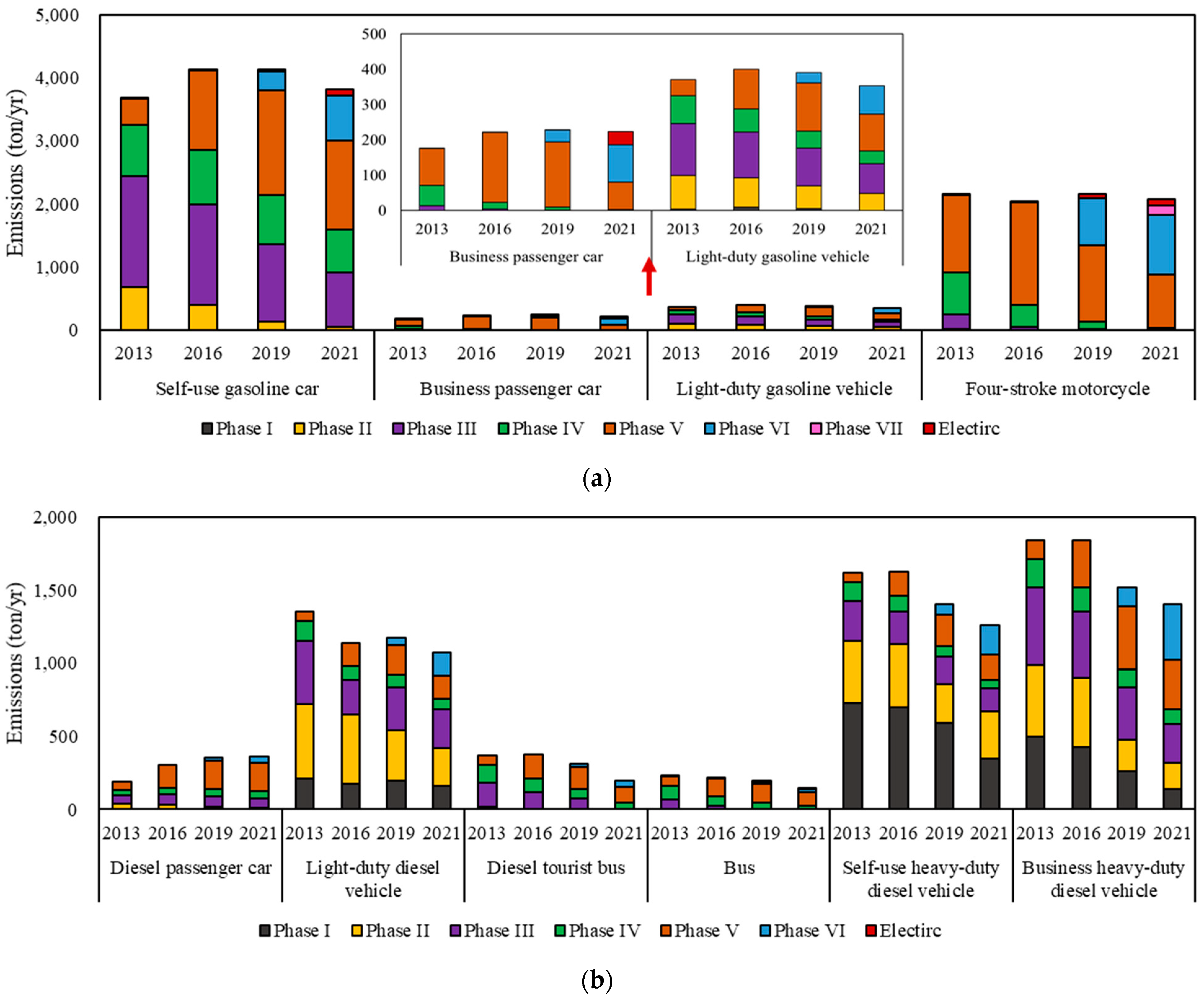
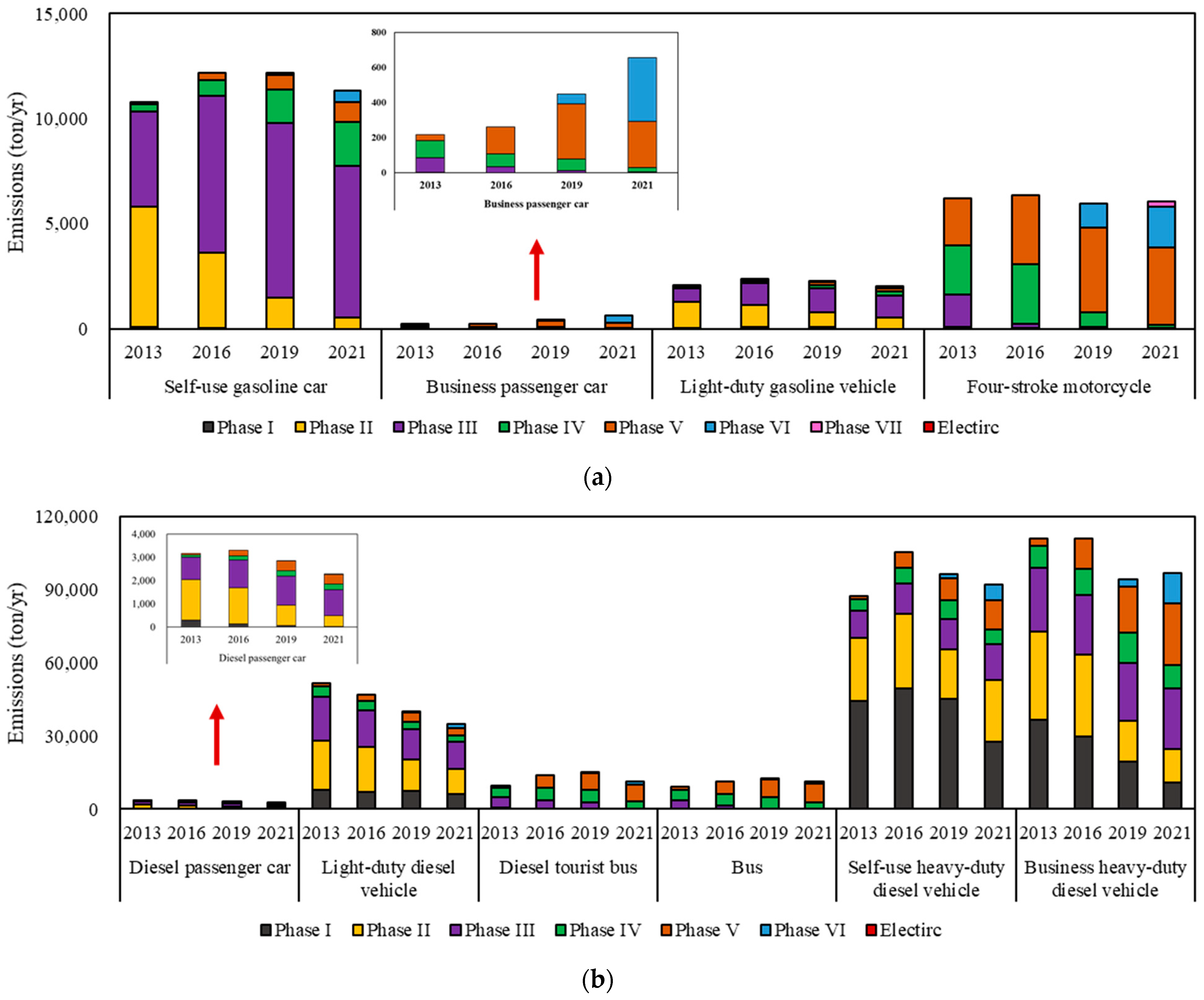

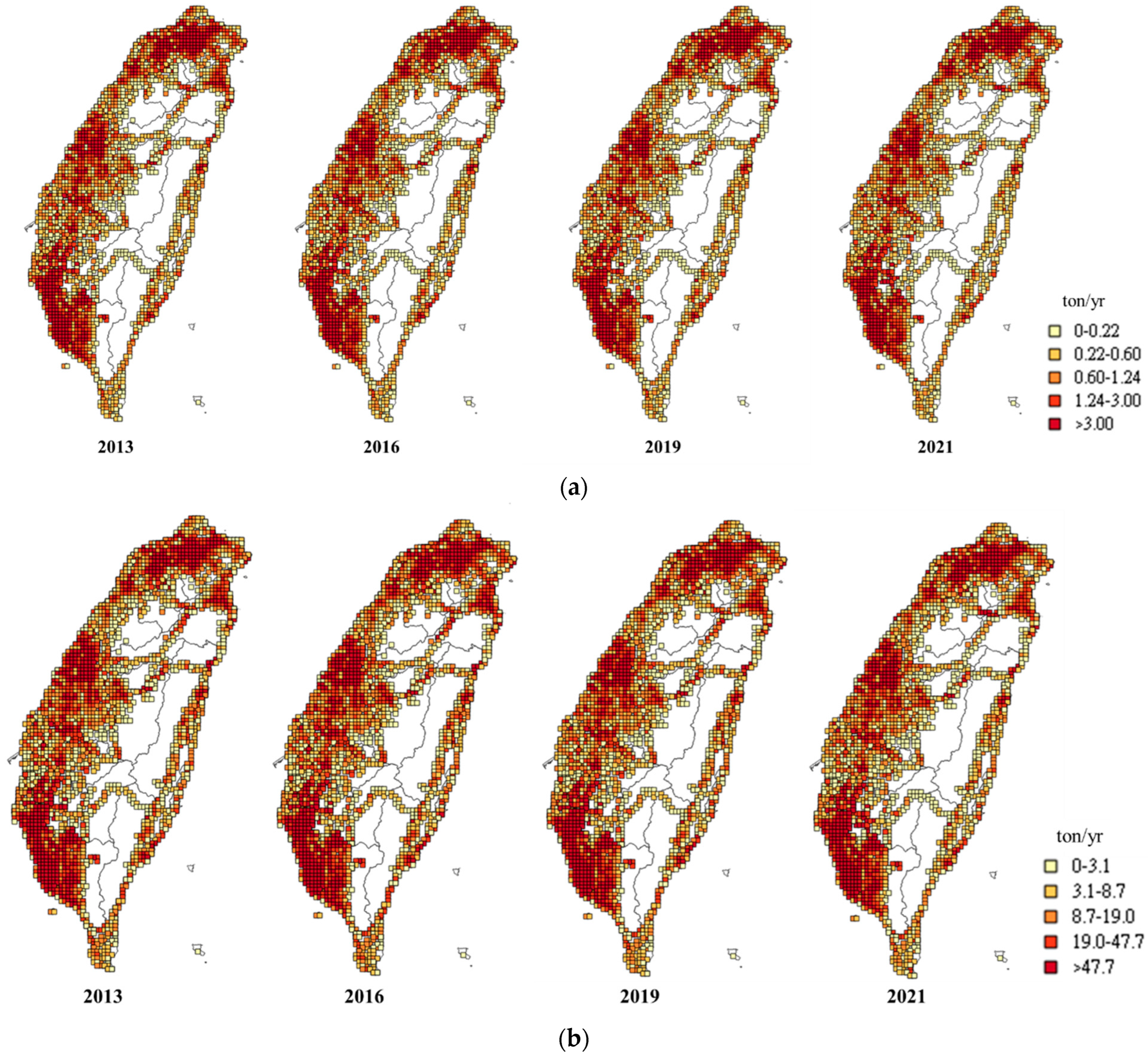
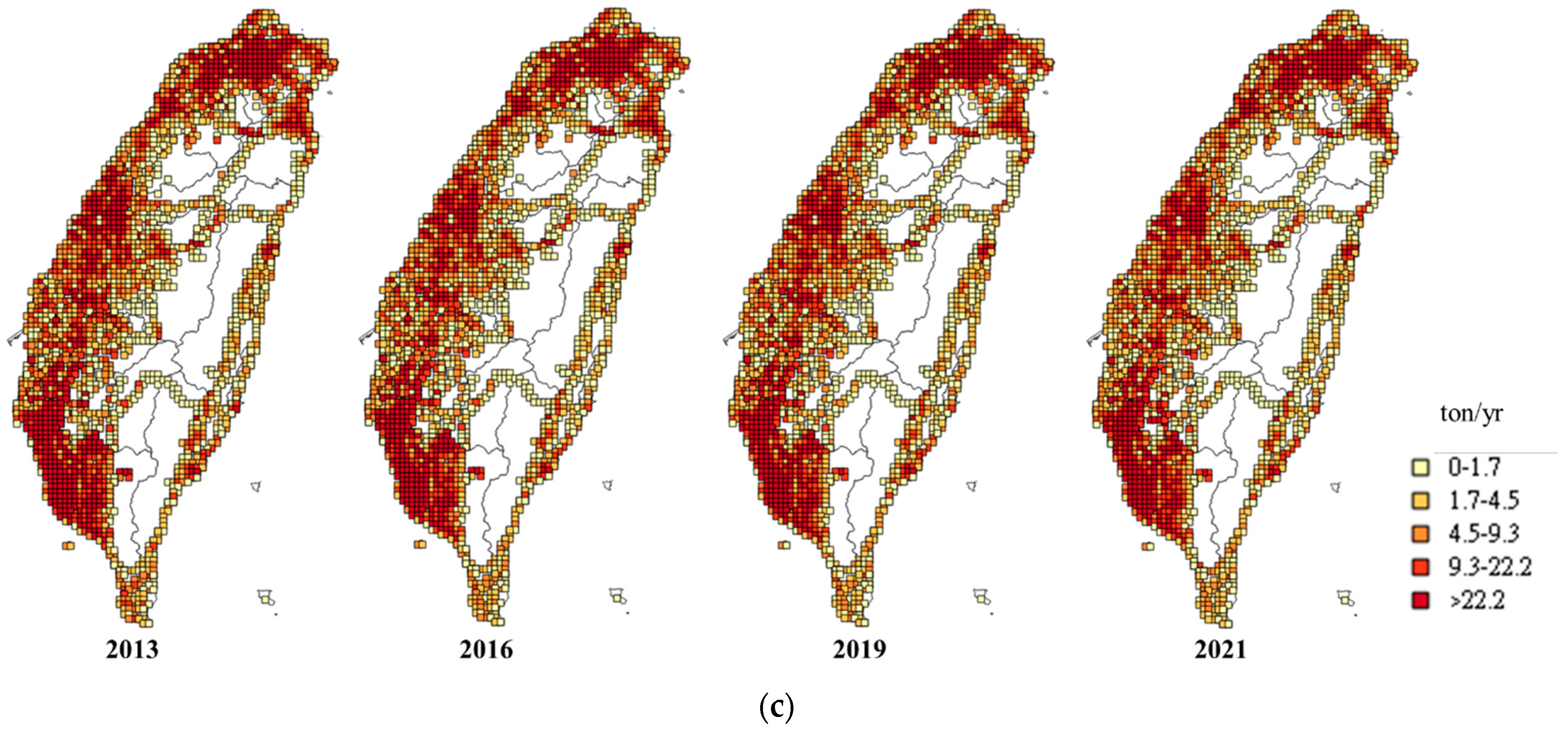

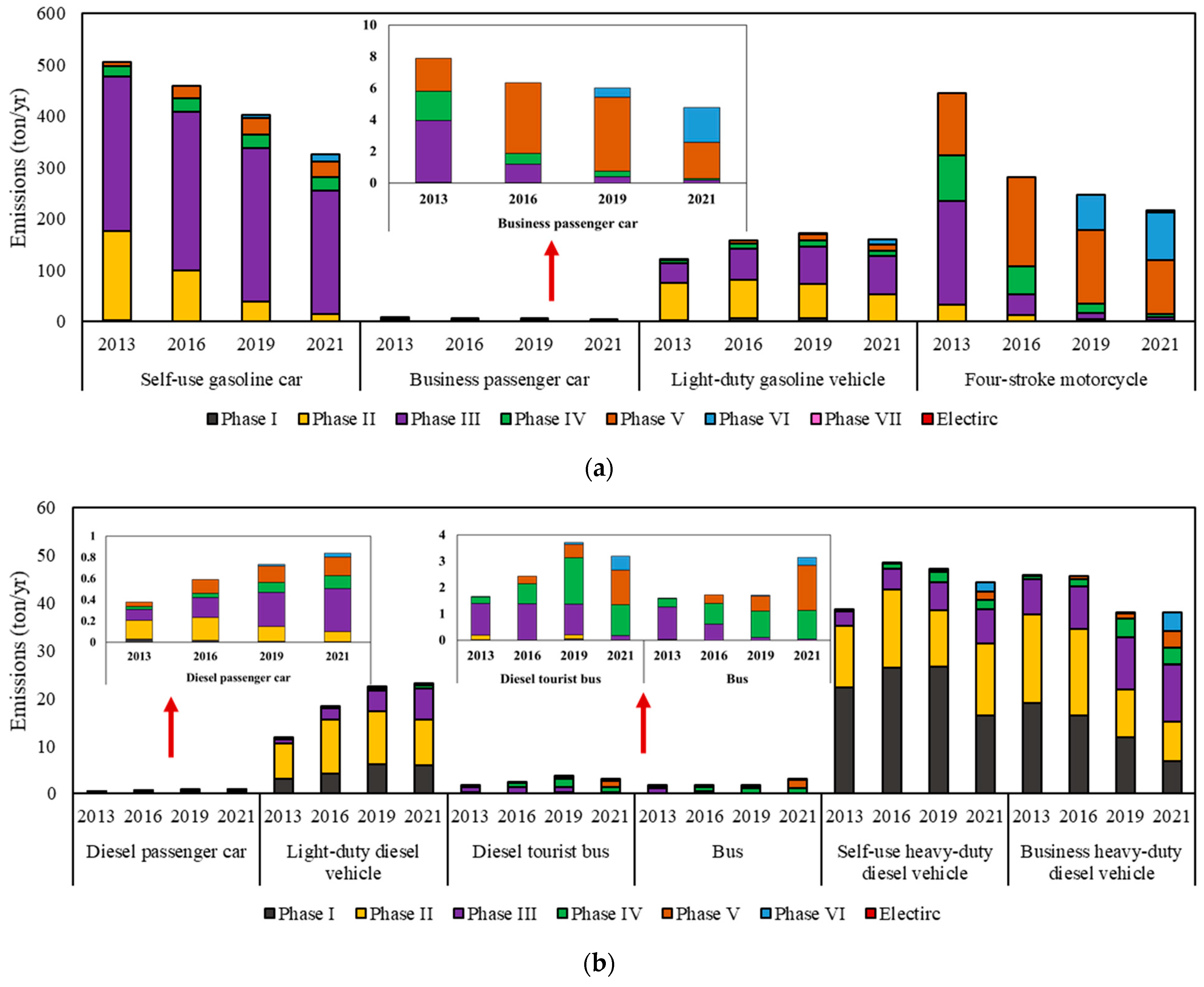
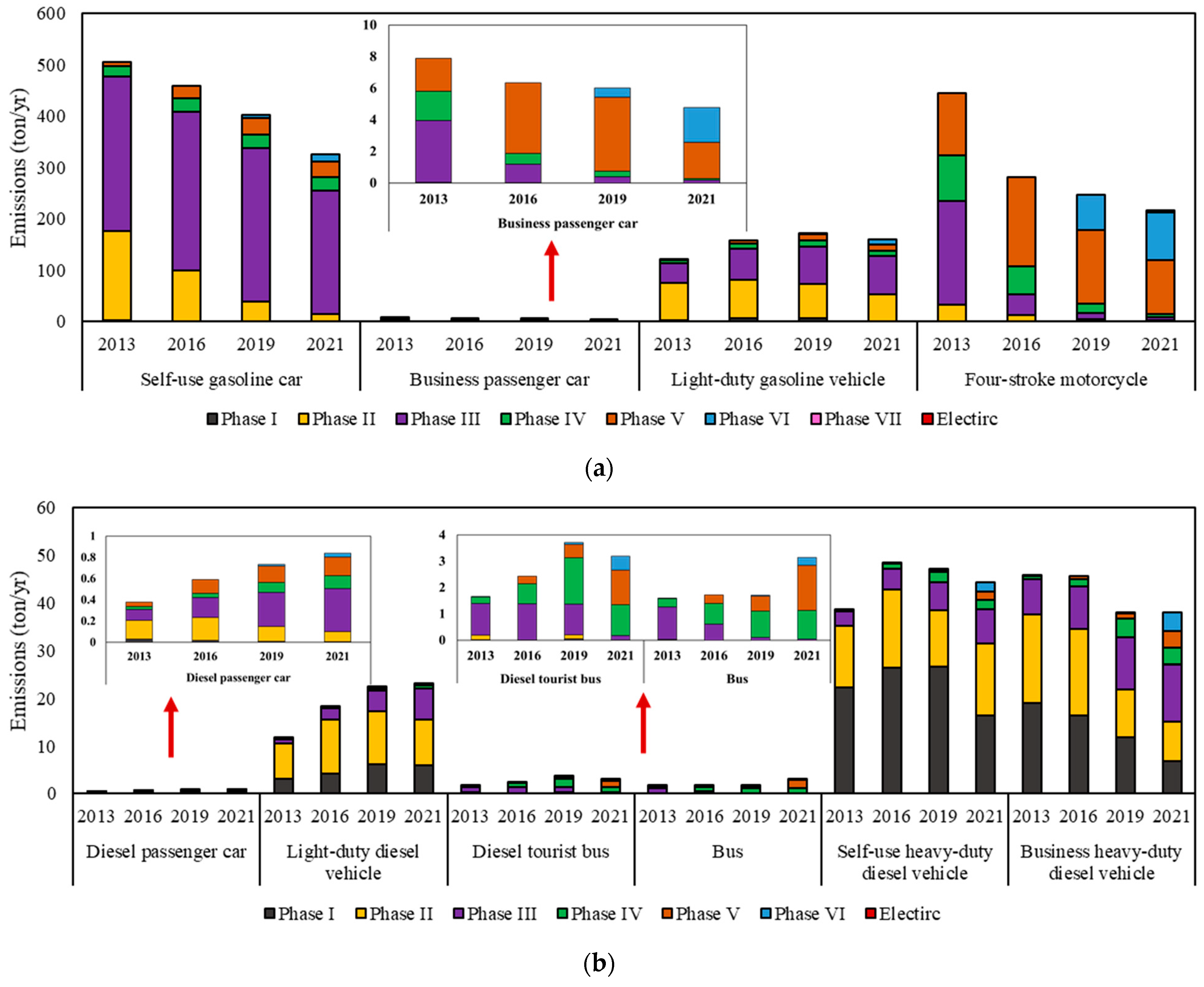
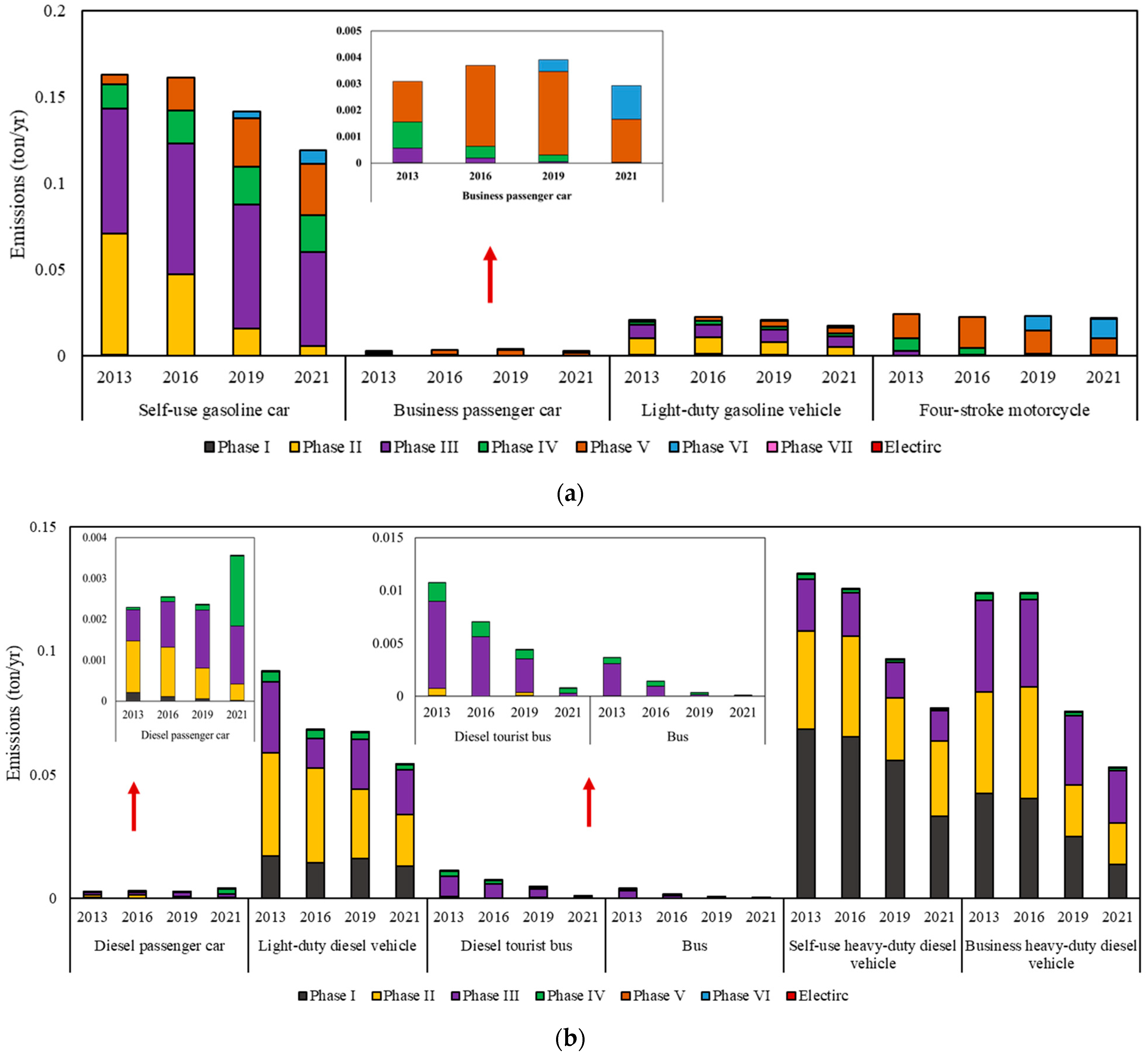

| Year | Passenger Car | Light-Duty Vehicle | Bus | Diesel Heavy-Duty Truck | Motorcycle | Specially Constructed Vehicle | |||||||||
|---|---|---|---|---|---|---|---|---|---|---|---|---|---|---|---|
| Self-Use | Business | Diesel | Electrical | Gasoline | Diesel | Diesel | Bus | Electric | Self-Use | Business | Motorcycle | Electric | Gasoline | Diesel | |
| 2013 | 5903 * | 177 | 156 | 0.4 | 578 | 298 | 17 | 15 | 0.08 | 92 | 70 | 14,157 | 38 | 31 | 30 |
| 2014 | 6038 | 184 | 184 | 0.4 | 587 | 303 | 17 | 15 | 0.12 | 94 | 70 | 13,694 | 42 | 31 | 31 |
| 2015 | 6171 | 189 | 213 | 0.5 | 595 | 309 | 18 | 15 | 0.13 | 95 | 71 | 13,610 | 52 | 31 | 32 |
| 2016 | 6235 | 191 | 239 | 0.5 | 598 | 313 | 19 | 15 | 0.21 | 96 | 71 | 13,596 | 72 | 31 | 33 |
| 2017 | 6303 | 197 | 260 | 3.5 | 602 | 318 | 18 | 16 | 0.26 | 97 | 70 | 13,642 | 114 | 31 | 34 |
| 2018 | 6362 | 203 | 271 | 10.4 | 602 | 324 | 18 | 16 | 0.46 | 96 | 69 | 13,641 | 195 | 31 | 34 |
| 2019 | 6404 | 202 | 277 | 36.6 | 603 | 331 | 17 | 15 | 0.47 | 96 | 70 | 13,633 | 360 | 31 | 35 |
| 2020 | 6431 | 195 | 280 | 78.5 | 601 | 340 | 17 | 15 | 0.56 | 97 | 71 | 13,648 | 456 | 31 | 36 |
| 2021 | 6445 | 188 | 282 | 144.4 | 600 | 350 | 16 | 15 | 0.74 | 97 | 73 | 13,643 | 544 | 31 | 37 |
Disclaimer/Publisher’s Note: The statements, opinions and data contained in all publications are solely those of the individual author(s) and contributor(s) and not of MDPI and/or the editor(s). MDPI and/or the editor(s) disclaim responsibility for any injury to people or property resulting from any ideas, methods, instructions or products referred to in the content. |
© 2023 by the authors. Licensee MDPI, Basel, Switzerland. This article is an open access article distributed under the terms and conditions of the Creative Commons Attribution (CC BY) license (https://creativecommons.org/licenses/by/4.0/).
Share and Cite
Tsai, J.-H.; Chen, J.-Y.; Chiang, H.-L. Airborne Air Pollutant Emission Characteristics of Mobile Vehicles in Taiwan. Atmosphere 2023, 14, 916. https://doi.org/10.3390/atmos14060916
Tsai J-H, Chen J-Y, Chiang H-L. Airborne Air Pollutant Emission Characteristics of Mobile Vehicles in Taiwan. Atmosphere. 2023; 14(6):916. https://doi.org/10.3390/atmos14060916
Chicago/Turabian StyleTsai, Jiun-Horng, Jian-You Chen, and Hung-Lung Chiang. 2023. "Airborne Air Pollutant Emission Characteristics of Mobile Vehicles in Taiwan" Atmosphere 14, no. 6: 916. https://doi.org/10.3390/atmos14060916




